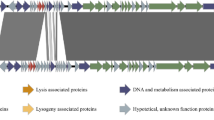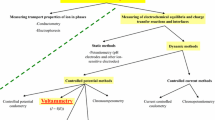Abstract
IN cultures of Corynebacterium diphtheriae the toxin is produced only within a relatively narrow range of iron concentration. Excess of iron inhibits toxin formation, but the mechanism of this phenomenon is not explained. Toxigenicity is strictly associated with the presence of prophage in diphtheria bacillus cells, and it has been recently suggested that iron probably affects toxin production by causing induction of the prophage–host system1. At iron excess a certain amount of atoxic, extracellular protein is found in the culture filtrate, but their physico-chemical and immunological properties are little known. A closer characterization of these components, which will be hereafter referred to as ‘Fe-proteins’, appears useful for work on toxin formation.
Similar content being viewed by others
References
Barksdale, L., Bact. Rev., 23, 202 (1959).
Radola, B. J., Bull. Acad. Polon. Sci., Sér. Sci. Biol., 8, 281, 287 (1960).
Radola, B. J., Bull. Acad. Polon. Sci., Sér. Sci. Biol., 8, 493, 499 (1960).
Author information
Authors and Affiliations
Rights and permissions
About this article
Cite this article
RADOLA, B. Electrophoretic and Immunoelectrophoretic Patterns of Extracellular Diphtheria Proteins from Culture Filtrates of Different Iron Concentrations. Nature 191, 382–383 (1961). https://doi.org/10.1038/191382a0
Issue Date:
DOI: https://doi.org/10.1038/191382a0
- Springer Nature Limited





